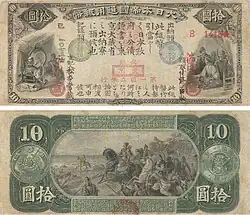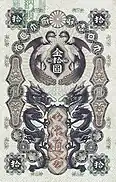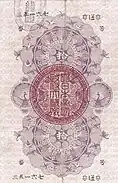10 yen note
The 10 yen note (10円券) was a denomination of Japanese yen for use in commerce.
| (Japan) | |
|---|---|
| Value | 10 Japanese yen |
| Security features | Watermarks |
| Years of printing | 1872–1946[lower-alpha 1] |
| Obverse | |
| Design | Various designs depending on the series. |
| Reverse | |
| Design | Various designs depending on the series. |
Government and National Bank Notes
Meiji Tsuho (1872-1879)
The first ten yen notes adopted and released by the Japanese government are part of a series known as Meiji Tsūhō (明治通宝). These notes were the first Japanese currency ever to be printed using western printing at Dondorf and Naumann, which was located in Frankfurt.[3] Meiji Tsuho notes were designed by Edoardo Chiossone sometime in 1870 while he was working for Dondorf Naumann on behalf of The National Bank in the Kingdom of Italy.[4] The process of making Chiossone's proposed design a reality started with the establishment of the "Imperial Printing Bureau of Japan" in 1871 (4th year of Meiji). In order to produce the currency the Japanese government reached out to Dondorf and Naumann to gain access to Western technology.[4] Chiossone had a falling out with Italian Bank as his relationship with them had hit a breaking point. When the company suggested Chiossone for the role as engraver, he quickly accepted the offer.[4] The production of money was handed over to the Imperial Printing Bureau in January 1872 when banknotes began to arrive from Germany.[5] All of these arrivals were purposely left incomplete due to security reasons, as the words "Meiji Tsuho" and the mark of the Minister of Finance were added by the Imperial Printing Bureau. Woodblock printing was eventually employed to save hundreds of people the work of handwriting the characters "Meiji Tsuho" on each individual note. Ten yen notes in particular were released in April 1872 (year 5 of Meiji) measuring 137mm x 89mm in size. Printing was initially done in Germany before Western technology was brought over to Japan. This allowed the Japanese government to produce some ten yen Meiji Tsūhō notes domestically. Overall, Meiji Tsūhō notes feature an elaborate design that was difficult to forge at the time as counterfeiting was previously rampant with clan notes.
The elaborate design worked against counterfeiters for an unknown period of time before they found a way around it. Processing Meiji Tsūhō notes at the time normally involved Japanese officials, who would add stamps to the notes finalizing the process. At some point in time under unknown circumstances unstamped notes sent to Japan from Germany were legally obtained by counterfeiters who then added their own stamps.[6] Another major issue was the Satsuma Rebellion in February 1877, which helped lead to massive inflation due to the amount of inconvertible notes issued for payment.[7] The Japanese government responded by halting the issuance of government notes in 1879 as a hopeful remedy to the situation.[8] During this time, legal tender Meiji Tsuho ten yen notes had issues with paper quality and were circulating with counterfeits. These problems led the Japanese government to issue redesigned ten yen banknotes in 1882 to replace the old Meiji Tsuho notes. Additional measures were subsequently put into place which included the establishment of a centralized bank known as the Bank of Japan. All of the remaining Meiji Tsuho notes in circulation that weren't already redeemed were to be retired in favor of either gold coinage or newly printed Bank of Japan notes. This period of exchange lapsed when Meiji Tsuho notes were abolished on December 9, 1899.[9]
National Bank Notes (1873-1880)

The idea for national bank notes (国立銀行紙幣) in Japan came from Itō Hirobumi when he was studying the United States in 1871.[10] During this time the Meiji government was working to establish a gold-backed monetary system based on Hirobumi's recommendation. The Japanese government accepted Hirobumi's proposal for national bank notes in 1872 by establishing the "National Bank Act" which organized a decentralized "U.S.-style" system of national banks.[10] Each of these banks was chartered by the state to issue notes exchangeable for gold from reserves held by the banks.[10][11] Permission was eventually given to these private banks allowing national bank notes to be issued in August 1873.[12][13] These first national bank notes are now referred to as old national bank notes (旧国立銀行券).[14]
Ten yen national bank notes in particular measure 80 mm x 190 mm in size and are modeled after their counterparts in the United States. The obverse features a Gagaku performance with convertible wording, while the reverse depicts Empress Jingū flanked by 10 yen gold coins. These circulated as convertible notes for roughly three years before the rising price of gold became an issue. An amendment to the National Bank Act was adopted in August 1876 making the notes inconvertible.[11][15][16] Under this amendment there was no limit on the amount of paper money that could be issued.[15] It also allowed private banks to redeem national bank notes for government issued inconvertible Meiji Tsuho notes rather than for gold.[16]
Notes
- April 1, 1955 is a de jure "suspension" date given by the Bank of Japan. While the final issue was last printed in 1946, these "A series" notes are still legal tender.[1][2]
References
- "Ten Yen Tickets". boj.or.jp. Bank of Japan. Archived from the original on October 5, 2020. Retrieved January 18, 2021.
- "Valid Bank of Japan Notes" (PDF). Bank of Japan. Archived from the original (PDF) on 2009-03-25. Retrieved December 14, 2022.
- "Japan - Great Japanese Government - Ministry of Finance 1872 Issue 10 Yen". Paper Money Guaranty. Archived from the original on August 28, 2023. Retrieved August 28, 2023.
- Gaoheng Zhang, Mario Mignone (2019). "A bridge of Art and Culture Connecting Italy and Japan". Exchanges and Parallels between Italy and East Asia. Cambridge Scholars Publishing. p. 223. ISBN 9781527544628. Archived from the original on 2023-10-25. Retrieved 2023-08-28.
- "Mint Ayumi" (PDF). Mint Ayumi Editorial Committee (in Japanese). 2010. Archived (PDF) from the original on 2023-08-28. Retrieved 2023-08-28.
- "過去に明治通宝の偽物が出回ったことも…". Kosen Kantei (in Japanese). Archived from the original on January 22, 2021. Retrieved December 21, 2020.
- Bureau of Foreign and Domestic Commerce (1929). "Effect of the Satsuma Rebellion". The Balance of International Payments of the United States in 1922-. U.S. Government Printing Office. p. 13-14. Archived from the original on 2023-10-25. Retrieved 2023-10-24.
- "The Gold Standard in Japan". Sound Currency. Sound Currency Committee of the Reform Club. 1899. p. 20. Archived from the original on 2023-10-25. Retrieved 2023-10-24.
- "国立銀行紙幣の通用及引換期限に関する法律". Ministry of Finance (Japan). Archived from the original on February 27, 2020. Retrieved December 27, 2020.
- Steven J. Ericson (2020). "Financial Policy in the Early Meiji Period". Financial Stabilization in Meiji Japan: The Impact of the Matsukata Reform. Cornell University Press. ISBN 9781501746932. Archived from the original on 2023-10-25. Retrieved 2023-10-24.
- "A historical chronology of the Bank of Japan". Bank of Japan (in Japanese). Archived from the original on January 16, 2021. Retrieved January 13, 2021.
- Japan Information Center (1964). "Coin, Coinage, and Currency in Japan". Japan Report. Vol. 10. Consulate General of Japan. p. 11. Archived from the original on 2023-10-25. Retrieved 2023-10-24.
- "Jingū as Western Amazon and Guardian Deity of Modernity". Performing "Nation": Gender Politics in Literature, Theater, and the Visual Arts of China and Japan, 1880-1940. BRILL. 2008. p. 85. ISBN 9789047443629. Archived from the original on 2023-10-25. Retrieved 2023-10-24.
- "旧国立銀行券5円紙幣の価値". Antique Coin Info (in Japanese). Archived from the original on April 15, 2021. Retrieved February 12, 2021.
- W. A. Browne (1899). "Bank Notes in the 1871 System". The Merchants' Handbook of Money, Weights and Measures, with Their British Equivalents. E. Stanford. p. 171-172. Archived from the original on 2023-10-25. Retrieved 2023-10-24.
- Wenkai He (2013). Paths toward the Modern Fiscal State. Harvard University Press. p. 102. ISBN 9780674074637. Archived from the original on 2023-10-25. Retrieved 2023-10-24.


